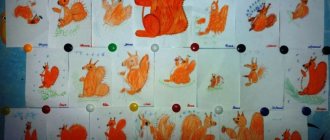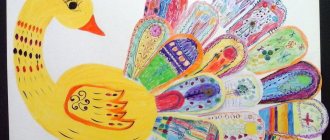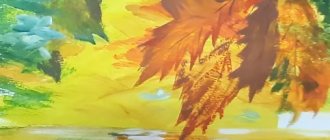On the topic: methodological developments, presentations and notes
Summary of a lesson on traffic rules in the middle group “Country of Traffic Rules”.
Systematize children's knowledge about traffic rules, signs and their meaning.
consolidate children's knowledge about traffic lights and their signals; systematize children's knowledge about road signs and their meaning; consolidate knowledge about land and air transport; develop observation and visual skills.
Lesson notes for children and parents “We follow the rules of the road.”
Source
summary of GCD in the middle group in fine arts "Pedestrian crossing sign"
Nikishina Irina Vyacheslavovna
MBDOU No. 16, Vyborg
Position: teacher
Abstract of GCD artistic and aesthetic development with children of the middle group “Pedestrian crossing”
Educator: Nikishina Irina Vyacheslavovna
Target:
consolidate children's knowledge of traffic rules.
Program content:
Learn to draw a “Pedestrian crossing” road sign, strengthen your skills in drawing with gouache, and strengthen your knowledge of traffic lights.
Develop attention, speech, memory.
Improve safe behavior skills on city streets.
Equipment
: brushes, gouache (watercolor), water jars, napkins, paper, demonstration material.
Children look at the “Crossroads” poster on the interactive board. The teacher asks them questions.
• What does the poster show?
• What types of transport do you see in the picture?
• Where are the cars located?
• Why did they stop?
If the traffic light is red for cars, what signal is at the traffic light for pedestrians?
How do people cross the road?
What stripes do you see on the road?
Educator. Now guess the riddles. Listen carefully, guess carefully.
Who always walks?
Guessed it?... ( Pedestrian)
Striped horses lay across the roads -
All the cars stopped if we passed here. ( Transition)
It will oblige us to drive quietly, a turn close will show us
And it will remind you what and how you are on your way... ( Road sign)
I blink my eyes tirelessly day and night,
I help cars and I want to help you. ( Traffic light)
Educator:
Well done, you know how to solve riddles, you guessed all the riddles correctly.
The teacher draws attention to the urgent letter that was sent to him on his phone. “Guys, I received an urgent message from Dunno, who lives in a magical city. And he doesn’t know at all what the “Pedestrian Crossing” sign looks like, and therefore he is afraid and does not know where he can cross the road. Let’s draw and give him this road sign so that he can put them up in his city and will no longer be afraid to cross the road.”
On the screen there is a picture of a road sign “Pedestrian crossing”.
Now let’s draw a road sign “Pedestrian crossing”. What geometric figure does this sign resemble? Who is in the center of the sign? What color background is the pedestrian walking against? What color is the pedestrian painted? What color are the zebra stripes? Now get to work.
physical education minute.
We are walking down the street. Children are marching, raising their knees high.
And we raise our knees.
Raise your arms above your head - Raise your arms up.
The guard was surprised. Moves hands left and right
Summary of a drawing lesson in the preparatory group “Cars on the Road”
Shamsutdinova Flyura Rafailovna
Summary of a drawing lesson in the preparatory group “Cars on the Road”
Notes on drawing in the preparatory group on the topic “ Cars on the road ”
Program content: Learn to depict various types of transport, their shape, structure, proportions (ratio of parts in size, consolidate the ability to easily depict an outline with a simple pencil and paint over it with pencils, develop the ability to complement the drawing with characteristic details, bring the idea to completion, evaluate your work, work carefully .
Equipment: pictures with different types of transport, roadways, wax crayons, a simple pencil.
Traffic rules in children's drawings
I. Statement of the problem
“Keep order, and order will keep you” Latin saying
The motorization of cities, the mobility of the population, and the aging of road transport infrastructure occur against the background of an indifferent attitude towards the possible consequences of road traffic injuries, a lack of adequate understanding by road users of the causes of accidents, and insufficient involvement of the population in activities to prevent road accidents.
The problems arising in connection with this require the development and implementation of preventive measures to prevent an increase in the number of accidents involving children, and propaganda work with the families of pupils.
Children are a special category of road users.
An analysis of modern methodological literature has shown that when teaching children the rules of behavior on the streets and roads, explanatory and illustrative methods are most widely used: conversations, didactic games, stories, reading works of fiction. They allow you to convey a large amount of information in the shortest possible time, pose problems to preschoolers and indicate ways to solve them, evoke vivid pictures and traffic situations in the mind, and activate memory and feelings.
II. Project goals and objectives
The goal of the creative project “Road Rules in Children’s Drawings” is to ensure that children consciously learn the rules of safe behavior on the streets and roads of the city and develop stereotypes of law-abiding behavior of road users.
Tasks on the way to achieving this goal:
- expand children's understanding of the rules of safe behavior on the streets and roads of the city through active forms of cognition: design, drawing, artistic and speech activities.
- teach children to reflect in their drawings their knowledge and ideas about the Rules of the Road, and share their experiences with others.
- to form stereotypes of law-abiding behavior among road users and to promote road safety.
III. Project participants
Project type: internal, group, interdisciplinary, mid-term.
Authors of the project: teachers of the 2nd junior group Shayakhmetova A.R., Sharafeeva Z.V.
Project participants: kindergarten children, teachers, senior teacher (project leader), music directors.
The project is carried out within the framework of integration of educational areas:
- "Safety",
- "Artistic creativity"
- "Communication",
- "Educational field of music".
IV. Project implementation timeframe
Project duration: November-December.
Project implementation stages:
- Stage 1 – search (2 weeks),
- Stage 2 – analytical (1 day),
- Stage 3 – practical (1-1.5 weeks),
- Stage 4 – presentation (1 week),
- Stage 5 – control (4 days).
V. Project implementation mechanism
Stage I – search
The main tasks of the search stage will be to search and analyze the problem, update the existing knowledge and experience of preschoolers, and set goals.
To achieve these goals, the following activities are planned:
- Organizing an excursion to a children's library in order to select books to read according to the rules of safe behavior on the streets and roads of the city, the history of transport.
- Conducting conversations with children to solve problem situations: “Rules and road safety”, “Being an exemplary pedestrian is allowed!” etc.
- Consolidating knowledge gained from books in didactic games “Road Signs”, “House, Street, City”, “Road and Safety”.
Stage II – analytical
The main tasks of stage II will be the analysis of available information and resources, the construction of an activity algorithm.
To achieve these goals, the following activities are planned:
- Clarification and classification of traffic rules
- Coming up with plots, discussing compositional solutions.
- Preparation of materials and equipment.
- Construction of an activity algorithm.
Stage III – practical
The main task of stage III will be the implementation of the planned technological operations.
To solve this problem, the following activities are planned:
- Drawing illustrations for the book “Road Rules in Children’s Drawings.”
- Children compose descriptive stories and comments on the plots of drawings.
- Design of the book for children and adults “Road Rules in Children’s Drawings.”
IV stage – presentation
The main tasks of stage IV will be the presentation of the project and the study of the possibilities of using project resources.
To achieve these goals, the following activities are planned:
- Presentation of the creative project “Road Rules in Children’s Drawings.”
- Making desk calendars with drawings from the book “Road Rules in Children’s Drawings.”
- Participation in campaigns to promote road safety.
Stage V – control
The main task of stage V will be to analyze the results of the project and formulate conclusions.
VI. Expected results
- Expanding preschoolers’ understanding of the rules of safe behavior on the streets and roads of the city.
- Children’s ability to reflect in drawings their knowledge and ideas about the Rules of the Road, compose descriptive stories, and share their experiences with others.
- Creation of the book “Road Rules in Children’s Drawings”, which makes it possible to promote road safety and form stereotypes of law-abiding behavior among road users.
VII. Evaluation of results
Studying the level of development of children in the educational field “Fundamentals of Life Safety”, the formation of ideas about the rules of safe behavior on the streets and roads.
The success of the creative project will be evidenced by the compilation of the book “Road Rules in Children’s Drawings.”
VIII. Further development of the project
In the future of the kindergarten:
- Making desk calendars with drawings from the book “Road Rules in Children’s Drawings.”
- Participation in campaigns to promote road safety.
Website for kindergarten teachers
Author Kuzyukova Daria Sergeevna has not indicated anything about herself yet.
10/14/2022 “Road Safety” Drawing “Traffic Light” Objectives: - to introduce children to the rules of the road; — help children understand road symbols and its specifics (using the example of road signs); - develop independence, reaction speed, and ingenuity in children; - to cultivate attention and concentration in children.
- introduce the meaning of a traffic light and its signals. Fix the name of red, yellow, green colors, fix to draw round objects.
Materials: - traffic light model, drawings depicting road signs.
Progress of the lesson: The teacher reads to the children the story “Why are road signs needed?” Ants are creatures, although small, but smart and hard-working. They run along ant paths all day long. Some - with luggage to the house, to the anthill. Others - away, with trash and light. Nobody quarrels with anyone, doesn’t collide.
Summary of GCD on traffic rules for children of the senior group “Traffic Light”
Fomichenko Olga Abstract of the GCD in the senior group on the topic “Traffic Light”.
● Foster a caring attitude towards health.
Goal: To consolidate knowledge about traffic rules. Objectives: Educational: learn to draw a traffic light, convey in the drawing the structure, shape and relative position of parts of an object; consolidate your neat painting skills. Developmental: develop observation skills, visual memory; ability to answer questions in complete sentences.
Educational: to raise disciplined pedestrians in preschoolers.
Integration of OO: “Cognition”, “Artistic creativity”, “Speech”, “Physical education”, “Social and communicative development”, “Reading fiction”.
Materials: landscape sheet, simple pencil, gouache, napkins, brushes, a glass of water, templates: rectangle (traffic light body, circles (lids from jars, circles of different colors for the game “Broken Traffic Light”. Contents of GCD. Organizational moment: children and teacher standing in a circle, greeting: Let's hold hands together and smile at each other.
The warmth will run in a circle. We are very glad to each other.
Educator: How are you feeling? Are you ready to travel with our new friend?
Children: Yes. Educator: Where is he? Where, Traffic light? The children and the teacher examine the group and other rooms, but do not find him anywhere. Surprise moment: The teacher notices a letter on a balloon. Educator: Guys, look at the letter. Reads: “Dear guys! I was kidnapped by the evil wizard Jurgen.
And now there is complete chaos in the Land of Traffic Lights.
But you can help me if you complete the tasks. Hurry up and I can get back to you. Your friend Traffic Light" Educator: Well, guys, let’s help Traffic Light?
We recommend reading: 6 7 15 federal law on operational intelligence activities
1. Tell us why a traffic light is needed on the street?
Children's answers. (To regulate traffic on the street.)
Progress of the lesson
— Guys, look at these photo illustrations, at the pictures. I want to draw your attention to something that we previously paid little attention to - the various symbols on the streets of our city.
Various road signs hang along the streets . Some you know.
For example, what do these signs ? (show children familiar signs - “Pedestrian crossing”
,
“Underground passage”
,
“Beware of children”
,
“Traffic prohibited”
and others).
See why all these signs are different in shape and color. There are round, triangular, square, on blue and white backgrounds. Do you know why they are so different? (children's answers)
These signs in red circles are prohibitive. Look: “Traffic prohibited”
,
“Bicycle traffic is prohibited”
,
“Pedestrian traffic is prohibited”
,
“turn is prohibited”
.
These are the strictest signs .
But these ones - in red triangles - are warning ones. They warn the driver about some kind of danger: “slippery road ”
,
“Rough
Road ” ,
“Dangerous Turn”
.
These signs on the blue circles are prescriptive. The driver must do what is shown on them.
Signs on square blue plates are informational or directional: “Pedestrian Crossing” sign
,
“Bus Stop”
and others.
(after display all
signs are removed ) .
Today I invite you to think and draw your own road sign . First, figure out what it will mean. Perhaps your sign will be very serious, strict, and perhaps humorous.
I suggest you first draw your sign with a pencil and only then work with color. (making drawings)
Lesson notes. Artistic creativity. Drawing. senior group Topic: “ROAD SIGNS”
Artistic creativity.
Drawing. senior group Topic: “ROAD SIGNS” Program content: Purpose: To familiarize children with warning and prohibition signs, service signs and special instruction signs. Objectives: Educational objectives: ● Reinforce with children the names of road signs and their meanings. ● Exercise your ability to draw road signs using different visual materials (colored pencils, wax crayons).
● To develop spatial orientation skills and conscious use of traffic rules in everyday life. ● Develop attention and creative imagination of children. Educational objectives: ● Develop skills for safe behavior on the road.
● Foster a desire to comply with traffic rules. ● Cultivate responsiveness (the desire to come to the rescue in difficult times by completing a task).
Methods and techniques: Surprise






